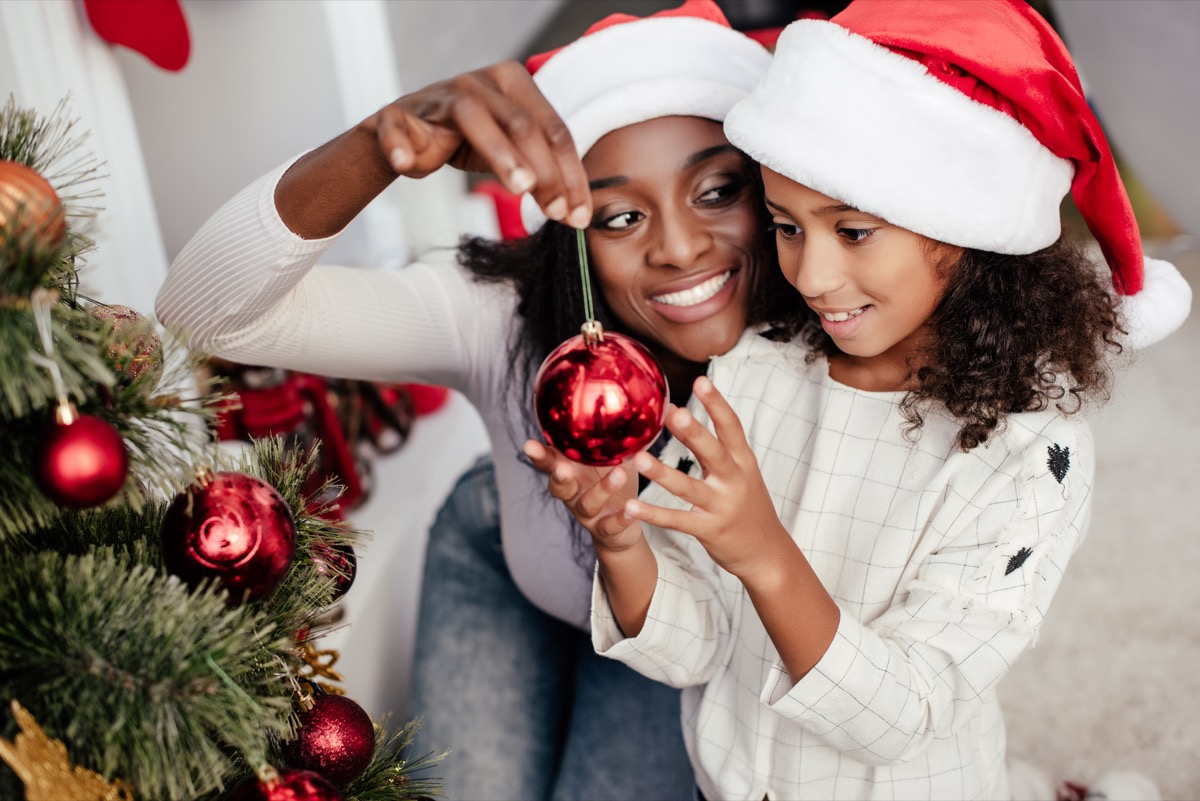10 Christmas Traditions’ Origin Stories That Will Surprise You

From kissing under the mistletoe to hanging stockings, it can seem like classic Christmas traditions are as old as the holiday itself. And while some rituals go back centuries, others are actually relatively recent developments. Thanks to a few famous poets, illustrators, entrepreneurs, and brands, the image of Santa Claus and the customs of Christmas have become more defined in the past 100 years or so, shaping it into the celebration we know and love today. To learn more about Christmas’s more recent history, here are the surprising backstories of some of the most familiar Christmas traditions!
1
Evergreen Christmas Trees

A number of influences brought about the modern Christmas tree. Evergreens had been used in winter festivals dating back to the time of the Ancient Romans, according to History. They decorated their homes and temples with wreaths and boughs for Saturnalia, a six-day festival celebrating the agricultural god Saturn. The trees became especially popular later in Germany as a symbol of the holiday.
Then, in the 19th century, it became more common to decorate branches with ornaments and tinsel. This was in part thanks to an 1848 sketch in the Illustrated London News of Queen Victoria and Prince Albert around a tree at Windsor Castle, which caught the attention of Americans and Europeans who wanted to follow the royal trendsetters. As William D. Crump explains in The Christmas Encyclopedia, at the turn of the 20th century, “only one in five families in the United States sported a Christmas tree; by 1930, the custom was almost universal.” In fact, the first Rockefeller Center Christmas tree was placed in New York City in 1931, followed by the tallest 100-foot tree in 1948, according to History.
2
Christmas Tree Lots

One of the main reasons it took time for Christmas trees to catch on in the United States is that it was challenging to find a tree unless you lived near a forest or wooded area. But that all began to change in 1851, when Mark Carr, a logger living in the Catskill Mountains, read about the growing interest in the trees. According to an 1878 New York Daily Tribune article, as quoted by The New York Times, Carr hauled an ox sled piled high with “thrifty young firs and spruces” to New York City. He set up shop in the now-defunct Washington Market and sold out quickly. Thus, the modern Christmas tree lot was born!
3
Christmas Ornaments

Originally, Christmas trees were decorated with household items like apples and cookies, then paper ornaments and dolls in the early 19th century, according to History. By the 1880s, retailers like F. W. Woolworth and his five-and-dime shops popularized glass ornaments, often sourced from German factories where they were made by hand. To illuminate the trees, candles were the go-to option for decades, despite the fact that they would often cause fires.
By the turn of the 20th century, small lanterns and glass balls that could hold the candles became more widely available. Electric Christmas lights (first invented by Thomas Edison’s associate Edward Johnson) would follow suit in 1900.
4
All Things Red and Green

It may seem like red and green have always symbolized Christmas, but it was actually fairly recently that they became the defining colors. According to Arielle Eckstut, co-author of Secret Language of Color, this was due to both holly and Coca-Cola. The former dates back to the Romans’ winter solstice celebrations. “Holly is associated with the crown of thorns of Jesus,” she told NPR. “Those beautiful bright red berries and those deep green leaves are the exact colors that we [picture] when we think about Christmas.”
Initially, a wide range of colors appeared on Victorian Christmas cards (Santa himself would wear blue, gold, and even green robes). Then, a massive marketing push from Coca-Cola in 1931 changed all that: The ads featured a red-and-white Santa at their center, helping confirm the now-classic Christmas colors. “It solidified in our collective imaginations the red of Santa’s robes with the green of fir trees and holly and poinsettia that we already had in our minds,” Eckstut said. “This particular shade of red and green came to signify Christmas.”
5
Jolly Saint Nick

Although Coca-Cola deserves some recognition for making red and green the official Christmas colors, it’s not exactly accurate to give the company sole credit (as many still do) for inventing the modern Santa Claus. The figure we know today came about through a number of important influences, beginning in the early 19th century.
In 1823, Clement Clarke Moore published his poem “A Visit from St. Nicholas” (better known as “‘Twas the Night Before Christmas”), which weaved together Santa Claus’s playful parts with his benevolent, more religious aspects, and gave him many identifiable traits, from his reindeer to his round size. But it was Thomas Nast, the popular illustrator for Harper’s Weekly in the mid-1800s, who helped create the image of the jolly man making toys in his workshop. Then, according to the Los Angeles Times, successors of Nast, like Norman Rockwell, put the finishing touches on the figure while marketers—most notably Coca-Cola—helped the icon become more deeply enmeshed in American culture.
6
Santa’s Sleigh

But before Moore, or Nast, or Rockwell, Washington Irving’s satirical A History of New York, published in 1809, included one of the first references of St. Nicholas in the United States. It describes him “jollily among the tree-tops, or over the roofs of the houses, now and then drawing forth magnificent presents from his breeches pockets, and dropping them down the chimneys of his favorites.”
In 1823, Moore’s “‘Twas the Night Before Christmas” cemented the idea of Santa having a sleigh with the stanzas: “When what to my wondering eyes did appear/But a miniature sleigh and eight tiny rein-deer/With a little old driver so lively and quick/I knew in a moment he must be St. Nick.”
7
Hanging Stockings

In the Netherlands, Dutch children have long stuffed their clogs with hay and carrots, leaving the shoes outside their homes on St. Nicholas Day (Dec. 6). According to Smithsonian magazine, the story goes that Santa takes the food for his reindeer and replaces it with coins or small treats for the kids to discover the next morning.
That idea eventually transferred over to the U.S. in the form of stuffing stockings. In 1823, Moore wrote how the jolly saint “fill’d all the stockings; then turn’d with a jerk/And laying his finger aside of his nose/And giving a nod, up the chimney he rose.” But the use of stockings really took off in the late 19th century, as “a variety of stocking especially designed for the reception of Christmas gifts” were introduced, according to an 1883 article in The New York Times. They were larger and more decorative than something a person would actually wear, which made the fireplace far more festive and ensured the tradition would carry on.
8
Christmas Carols

The act of strolling house to house to spread holiday cheer goes back to at least the 15th century, as “wassailers” would travel to different homes, wishing one another well. However, it wasn’t until the 19th century that singing holiday songs became part of the fun, with those in Victorian England merging traditional church carols with Christian folk music, according to Time.
“At that time, it was far from a Christmas tradition; festivals like May Day were deemed worthy of caroling, too,” according to the magazine. “In the 19th century, as Christmas became more commercialized and popular, publishers began churning out anthologies of carols, many of which were ancient hymns, also circulating them in broadsheets.”
9
Letters to Santa

Many kids today send letters to Santa Claus, but this wasn’t always the case. The correspondence actually started from Santa to children. He’d write to them, encouraging them to behave and describing ways in which they were naughty or nice the past year, according to Time.
Soon enough, kids started writing back, placing their letters on the fireplace, and, once the postal service became more widespread, through the mail. Newspapers would publish and answer letters, as well as local charity groups before the post office eventually stepped in in the first half of the 1900s and took over the responsibility.
10
Mistletoe

For centuries, mistletoe was associated with fertility and vitality, due to the fact that it blossomed even during the coldest seasons. “Just how it made the jump from sacred herb to holiday decoration remains up for debate, but the kissing tradition appears to have first caught on among servants in England before spreading to the middle classes,” according to History. Holiday revelers would pluck a single berry from the mistletoe, kissing each time until the berries were gone. A better-known tradition was that men would be “allowed” to smooch a woman standing under the mistletoe. It should go without saying, though, that if you’re at a holiday party this season, you’d be wise to keep your lips to yourself.